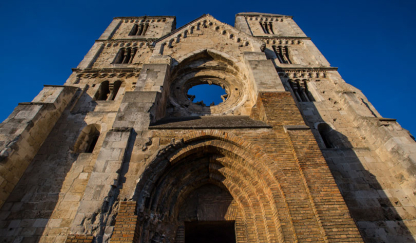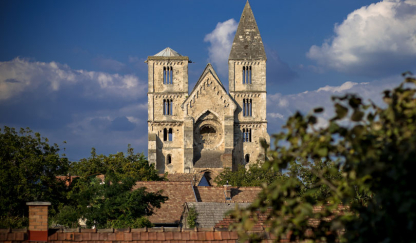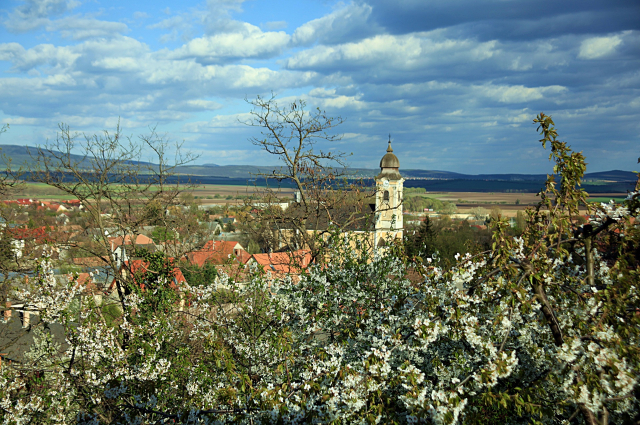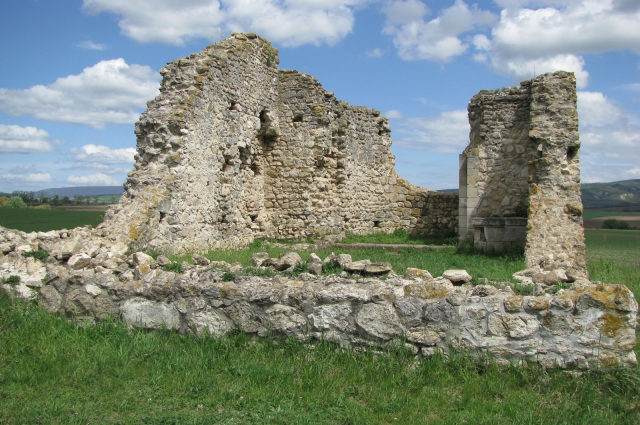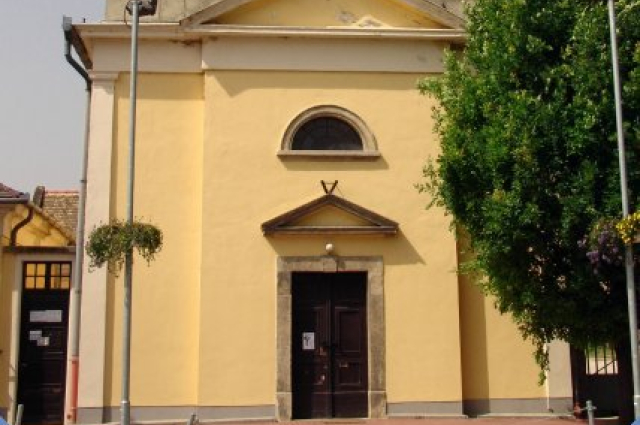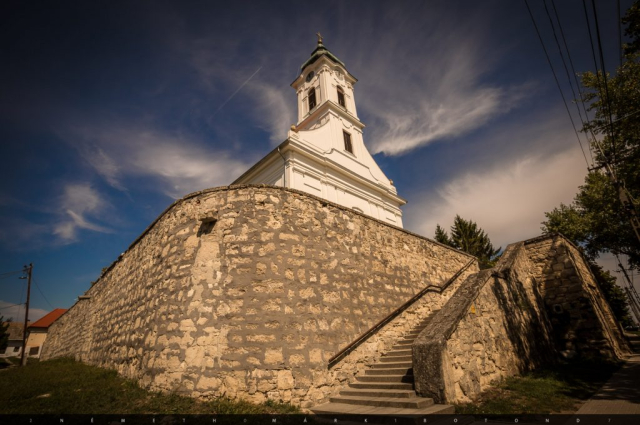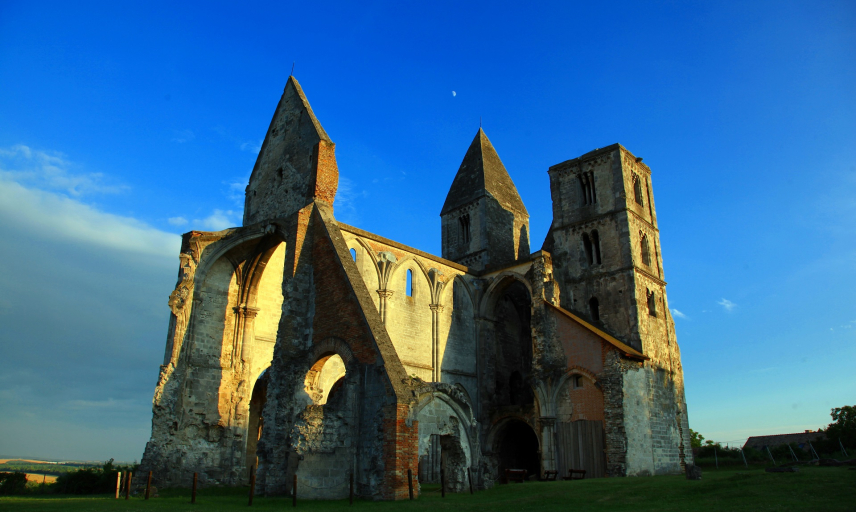
Church Ruins
The ruin of the former Prémontré monastery is one of the greatest and – in terms of simplicity – monumental creations of 18th century Hungarian architecture, and at the same time an emblematic sight in Zsámbék.
The Church Ruins registered as one of the country’s important listed monuments is a worthy member of the group of finest Roman era relics, the churches in Lébény and Ják.
The Church Ruins stand on a 200 meter high hill, allowing us to catch a first glimpse of them from any point of the Zsámbék Basin. A village church stood on the site back in 1030, according to the laws of St. Stephen. A three-nave basilica was built on the site of the former single-nave church in late Roman and early Gothic style in the late 13th century, which was 38 meters in length and 24 meters wide, and was later extended to include the associated 4,000 m2 monastery.
The Roman nature is primarily illustrated by external forms, whereas the Gothic style primarily appears in the stone carvings inside. Decorative vegetation elements include the lily, three-leaf clover and grape, and figurative decorative elements include the dragon, but a depiction of a human figure can also be detected: a monk sitting in his robe.
We do not have any chronicle left over of construction of the three-nave basilica. Some sources link the appearance of the Aynard clan that may be related to foundation of the monastery, and their settlement in the Zsámbék area to Kálmán Könyves’ (Coloman the Book-lover’s) first wife, to the daughter of the Norman prince of Sicily, whereas others (and perhaps this is closer to the truth) link these phenomena to the wife of Béla III, Margit Capet, and to the French noble family who came here in her retinue.
Based on former documents it is certain that Aynard’s kindred Comes (Steward) Smaragd donated part of the estate to the French Order of Prémontré monks in around 1220 and a family and clan monastery was founded in honor of John the Baptist. The Order operated the church and monastery until the 15th century. in 1475 King Matthias – with the Pope’s permission – handed over ownership to the monks of the Order of St. Paul. The monks of the Hungarian order rebuilt the monastery, constructed the western wing, and renovated the cloister in Gothic style. The northern tower of the church and the rose window of the western gable wall were transformed in Gothic style, according to the fashion of the time. A foyer was erected in front of the southern gate, which was covered with a star vault.
After the fall of Buda in 1541 the Turks also took control of Zsámbék until the end of the 17th century, but even before then the basilica was struck by several blows and destructive forces. The Tatars set it on fire in 1242; the attack is verified by the Tatar arrow tip found near the round window, while the Turks used it as a castle, as witnessed by the damage to the rose window between the two towers. The tragedy of the church, however, was caused by a natural disaster, the earthquake of 1763, measured at 6.3 on the Richter scale and recorded in chronicles as Hungary’s largest earthquake.
After the Turks were expelled, the almost completely depopulated village came into the ownership of the Zichy family. Settlers arrived from four German provinces and from Galicia between 1710 and 1760 and they repopulated Zsámbék.
The region was not only literally shaken by the earthquake, but was also devastated by two epidemics: the plague and cholera. In the next 110 years or so – until the establishment of monument protection in Hungary (1872) – the church and monastery were looked on as a quarry by the locals and were used to rebuild Zsámbék. In order to improve the living conditions of the families living here, largely in cellars dug in the ground, adobe houses were built with stone foundations using the stones of the monastery and church.
In 1889 the architect István Möller was commissioned to conserve the ruins by the National Commission for the Protection of Monuments. In the absence of sufficient material resources, bricks were used as structural reinforcement of the church, clearly signaling the old and new parts of the building structure. By means of conservations works carried out on the Church Ruins, István Möller was 70 years ahead of his time in relation to the fundamental principles of the Venice Charter (Convention for the Conservation and Restoration of Monuments and Sites). To commemorate his work, the kneeler created by Miklós Melocco and visible at the top of the lapidarium was completed in 1989.
Kálmán Lux and Géza Lux revealed the walls of the monastery next to the church between 1934 and 1939. Today’s exhibition space, the lapidarium, was developed from the dining room with embrasure windows and a vault in the medieval order’s late Roman style. A cellar system is located to the west of here and this was used to store food and control wine temperature in the Middle Ages.
The church was struck by lightning in 1963; the top of the intact tower was damaged. A lightning protection system was then constructed, and the artificial stone supplement was completed on the eastern side of the church.
Following archaeological research, conservation work restarted on the site in 1986. Under the leadership of archaeologist Dr. Ilona Valter, 463 graves were opened up. The Aynard clan’s graves were found inside the church, the monks in the inner courtyard of the cloister, and a village cemetery around the church.
We have the opportunity for time travel in the lapidarium by virtue of the collection of stones carved from the 13th and 15th centuries, and the exhibition presenting the history of the church, the first conservation works, and the results of archaeological research.
The architect working on the final conservation, following excavations from 1992 to 2000, was János Seidmayer. Based on his designs, the church nave was reinforced, the external spiral staircase constructed and the pillars and buttresses were reinforced. At the initiative of the local government the group of monuments was opened to visitors again in 2003. Anyone visiting should not miss the lapidarium if only because there is an unparalleled view of the Zsámbék Basin from the top.
The Church Ruins signify a consecrated, sacred site, and any other events apart from visits (weddings, christenings, holy mass services, etc.) can therefore only be held by adapting to this fact.
CHURCH RUINS
Address: Zsámbék, Corvin János u. 1.
GPS: 47.324767, 18.4325
Admission ticket prices:
Adults: 700 HUF/person
Students, pensioners: 400 HUF/person
Groups (over 10 persons): 400 HUF/person
Groups (over 10 persons, students, pensioners): 300 HUF/person
Family admission: (2 adults + 2 children) 1,400 HUF
Support tickets: 100, 200, 300, 500 HUF
Guided tours: 4,000 HUF
Opening hours:
between 1 April and 31 October, except Mondays, daily between 10:00 and 18:00
between 1 November and 31 March, except Mondays, between 10:00 and 16:00
Similar results
Baroque parish church
Zsámbék, 2072 Petőfi Sándor utca 1.The single-nave Roman Catholic church with a single tower built in Baroque style stands on the corner of Magyar utca and Petőfi...
MoreRossztemplom (Ruined Church)
2073 Tök, Rossztemplom-dűlőThe small church built around 2 km northeast of today’s village could once have been the parish church.
MoreRoman Catholic St. Anna Church
2051 Biatorbágy, Szentháromság tér 3.The Bia St. Anna Parish Church, which is subject to national monument protection, was built as a chapel to Sándor-Metternich...
MoreVisitation of Our Lady Church
2091 Etyek, Hősök tere 17.In Etyek the Roman Catholic Church and Parish of the operation we have data since 1723rd Compared to the increased population of...
More